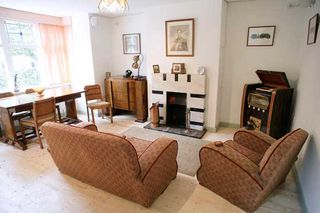Powerful Ideas: Teaching an Old House New Tricks

Editor's Note: This occasional series looks at powerful ideas — some existing, some futuristic — for fueling and electrifying modern life.
New houses are being built to be more energy efficient all the time. However, the majority of existing U.S. homes were built more than 30 years ago when efficiency standards were much lower. Researchers are looking at how to make these energy-wasting old-timers more thrifty.
About one-third of the nation's energy consumption comes from the residential sector. A large fraction of this — roughly 70 percent — can be attributed to homes built before 1983, according to a recent study by ConSol, a building consultant firm in California.
"If you look at existing homes built in the 1940s and 50s, you find they use two to three times as much energy as currently built homes," said Jim Hodgson, a project engineer at ConSol.
Retrofitting older homes with new efficiency features can make a big difference. A research group in England has recently constructed a house in a 1930s style in order to test energy-saving improvements.
Home-made experiment
The average U.K. household spends 60 percent of its energy on space heating, but a lot of this energy is wasted in old homes that are poorly insulated, said Mark Gillott of the University of Nottingham.
Sign up for the Live Science daily newsletter now
Get the world’s most fascinating discoveries delivered straight to your inbox.
Gillott and his colleagues have reconstructed a "semi" — a traditional English house from the 1930s that can still be found in some neighborhoods — and asked a family to move in for three years, starting this past fall. The goal is to see where energy is being lost and how best to retain it.
The model "semi" has single-paned windows and no insulation, which is typical of many older homes. To study the efficiency, 100 sensors have been placed throughout the house to measure such things as heat loss, air leakage and electricity consumption.
Each family member also wears a tracking device, so that Gillott's group can tag whose using what and when.
"We can almost give individual carbon footprints," Gillott told LiveScience. "This will help understand the effects of human behavior, since it's not the building that uses the energy, it's the people."
Once initial data is taken on the household, the researchers will begin to retrofit the "antique" home by adding insulation, sealing air leaks, adding a modern heating system and putting in more efficient lights and appliances. The goal will first be to reduce energy use by 70 to 80 percent, and then make the house a zero-carbon emitter with solar panels and other renewable technologies.
It's not too late to insulate
Probably the easiest way to improve the energy performance of an old house or building is to beef up the insulation.
"If you can only do one thing, it should be the insulation," said Eric Magnan, an official for the city of Lyon, France, in charge of heating and cooling in 400 public buildings.
The French government has committed to reducing greenhouse gas emissions by a factor of four by 2050. For his part, Magnan is searching for ways to make buildings do more with less.
"It will not be easy, even with 40 years to work on it," Magnan said. A lot of promising technologies, such as heat pumps and solar panels, have yet to fully mature. Home insulation, on the other hand, has been around for more than half a century.
"It's the non-sexy technology," Gillott said. "A lot of people want to put something on their roofs like solar panels or a wind turbine that everyone can see. Nobody sees insulation, but it works the hardest."
Insulation is often characterized by an R-value, which measures the thermal resistance of a material. For example, glass fiber — the most common type of insulation — has an R-value of around R-3 per inch of thickness.
According to the ConSol study, California homes built in the 60s or 70s typically have total attic insulation between R-5 and R-10, whereas the U.S. Department of Energy recommends new homes have at least R-30 to keep a lid on the heat.
Low-hanging fruit
To investigate the potential gains of retrofitting an older house, Hodgson's team considered spending $10,000 to rejuvenate a 1960s home. For that money, one can typically improve attic insulation, upgrade the heating/cooling system and install double-pane windows.
"These are the low-hanging fruit that can make a huge impact," Hodgson said.
They found that such a retrofit on a single home could save 8.5 tons of greenhouse gas emissions per year in reduced energy consumption, which translates into spending $1,176 per saved ton (the cost could be less if one qualifies for tax breaks and/or utility rebates).
In comparison, increasing the energy efficiency of a new home by 35 percent would cost about $5,000 and would reduce emissions by only 1.1 tons at a cost of $4,545 per ton.
"We're getting diminishing returns from new homes," Hodgson said. "Older homes are where significant gains can be made."
- Powerful Ideas: Humans as Renewable Sources
- Video: How to Convert Solar Energy
- Video: The Story of Wind Power
Most Popular


